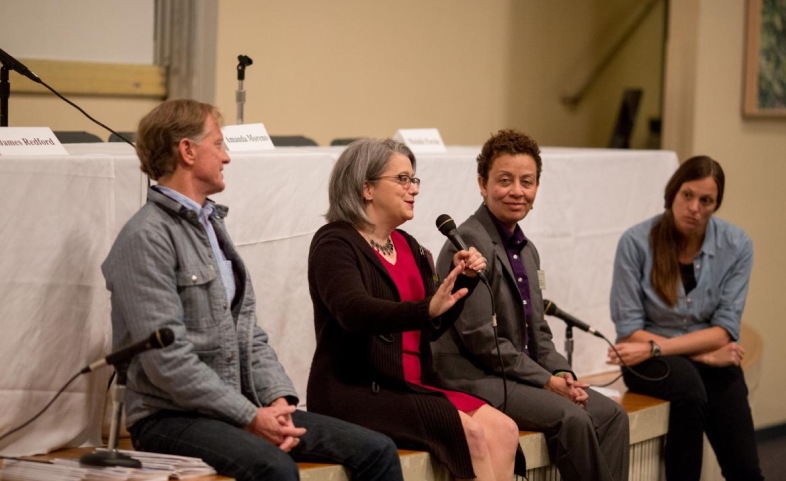
‘Paper Tigers’ Documentary Offers Solutions to Teaching Traumatized Kids
The film “Paper Tigers” opens with what looks like phone camera footage of a fight. There’s a splatter of blood, shouting, a chair flying across a classroom.
Photo credit: EWA

The film “Paper Tigers” opens with what looks like phone camera footage of a fight. There’s a splatter of blood, shouting, a chair flying across a classroom.
Photo credit: EWA
The voiceover is a patchwork of voices saying things like: “This place is absolute chaos.” And: “All the kids were forced to be here.” And: “That’s where the bad kids went.”
Lincoln Alternative High School, in Walla Walla, Washington, is where all the bad kids went. Not anymore. In the early 2010’s, Principal Jim Sporleder, along with a dedicated team of teachers, took the chaotic mess that was Lincoln and made it a healthy place for students.
Director James Redford (yes, that Redford, son of Robert) spent a year capturing the turnaround school on tape to make “Paper Tigers,” a poignant two-hour documentary on how the Lincoln team was able to treat the toxic stress of their students through unswerving dedication.
“There’s this myth that we all have to pull ourselves up by our bootstraps,” Redford said after the screening, held at the Education Writers Association’s 2016 National Seminar in Boston. “Resilience, on a whole, has to be built.”
To build resilience among their students, the Lincoln team didn’t focus on increasing rigor or bringing up test scores. Instead, they fundamentally changed the way they taught and interacted with children. They acknowledged the kids’ hardships and asked them to work to move past those things, but not to ignore the effects of their circumstances.
“Paper Tigers” is worth seeing for reporters who cover traumatized student communities, especially rural ones like the town highlighted in the film. It manages to tell the detailed and heartbreaking stories of six students while weaving in findings from the research on adverse childhood experiences, the importance of accessible mental and physical health care, and the challenge of getting students from disadvantaged backgrounds out of high school and into college.
“It would be easy to let them fight, get suspended and get them out of here,” a voice – it was hard to tell if it was the principal or the science teacher – says at one point in the film. “That would be the easy route.”
These teachers did not take the easy route. And it worked.
“This is the first place that I’ve ever been to that I felt they cared about me as an individual,” said Aaron, 17, and one of the film’s stars. (Aaron, who could hardly maintain eye contact with teachers at the beginning of his senior year, made it to college and is doing great there, according to Redford.)
The discussion following the screening was far-ranging. Reporters asked if early childhood education would have helped the students. That wouldn’t have removed the kids entirely from their toxic environments, said Amanda Moreno of the Erickson Institute, a graduate school for early educators in Chicago. And though she believes strongly in early interventions, she said they aren’t an inoculation against the rest of a tough childhood.
Instead, Moreno said, educators at all levels should offer students consistency and acceptance. Think of it, she said, like “a big old wall of love.”
“There is this growing understanding that focusing on a student’s social-emotional skills, and a teacher’s social-emotional skills” is critical, she said. “You’re not going to get anywhere without it.”
Yet neither education schools nor alternative certification programs are paying enough attention to these areas, said Boston University Professor Michelle Porche. “But we’re thinking about it a lot more,” she said.
The question was also raised about whether a program like Lincoln’s was replicable, or if it depended too much on a charismatic team working unsustainably hard. The panelists didn’t know the answer to that question, but agreed it was worth asking.
As for how he got the story, Redford said a key turning point came in December of the school year, when he stopped just showing up to film the kids and gave them their own video cameras instead.
“I said, ‘you don’t have to talk to me. I’m not going to tell you what to say. You can say nothing. Anything,’” Redford told the screening audience. That did the trick. The kids began to open up. After that, the film came together quickly, he said.
Redford also played it especially safe in terms of what he put on screen, he said. He’d felt it was too easy to get permission from unengaged parents and guardians, so he left things out he thought might hurt the kids and (in a first) he also let them watch and approve a final cut before he began showing it more broadly.
“I probably missed all kinda of dramatic, compelling things in storytelling because that’s not cool,” Redford said. He still thinks it was worthwhile to be cautious and reports that, so far, the kids have “no regrets” about what’s in the film.
All told, “Paper Tigers” managed to take another one of those jargon-y education terms, “trauma-informed instruction,” and make it come alive. At its best, the film showed a possible path forward for schools and teachers trying to serve students primed for fight or flight even when faced with tigers made only of paper.
Your post will be on the website shortly.
We will get back to you shortly